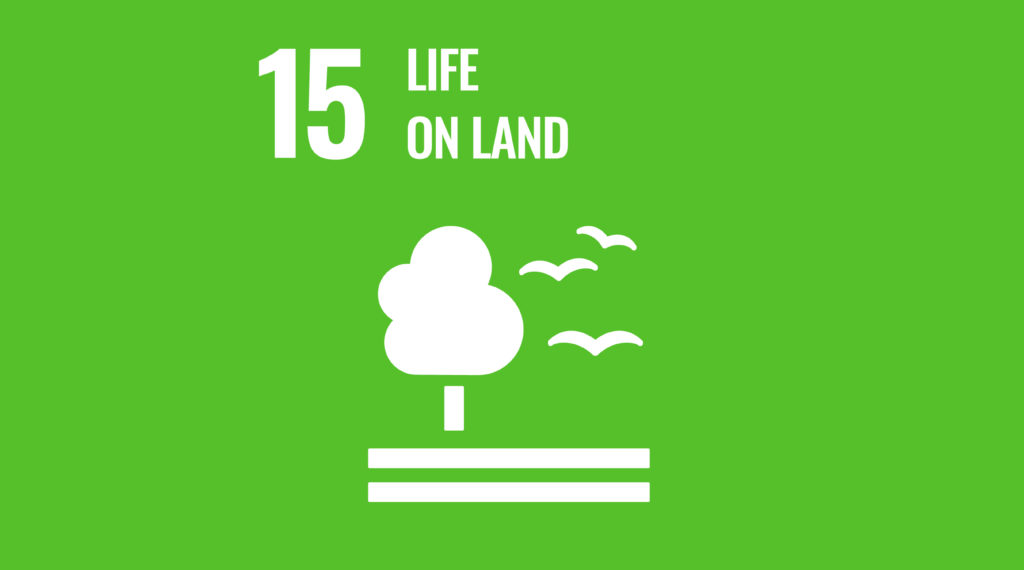Life on Land
Nature is critical to our survival: nature provides us with our oxygen, regulates our weather patterns, pollinates our crops, produces our food, feed and fibre. But it is under increasing stress. Human activity has altered almost 75 per cent of the earth’s surface, squeezing wildlife and nature into an ever-smaller corner of the planet.
Around 1 million animal and plant species are threatened with extinction – many within decades – according to the 2019 Global Assessment Report on Biodiversity and Ecosystem Service. The report called for transformative changes to restore and protect nature. It found that the health of ecosystems on which we and all other species depend is deteriorating more rapidly than ever, affecting the very foundations of our economies, livelihoods, food security, health and quality of life worldwide.
Deforestation and desertification – caused by human activities and climate change – pose major challenges to sustainable development and have affected the lives and livelihoods of millions of people. Forests are vitally important for sustaining life on Earth, and play a major role in the fight against climate change. And investing in land restoration is critical for improving livelihoods, reducing vulnerabilities, and reducing risks for the economy.
The health of our planet also plays an important role in the emergence of zoonotic diseases, i.e. diseases that are transmissible between animals and humans. As we continue to encroach on fragile ecosystems, we bring humans into ever-greater contact with wildlife, enabling pathogens in wildlife to spill over to livestock and humans, increasing the risk of disease emergence and amplification.
Sustainable Development Goals
The 2030 Agenda for Sustainable Development was adopted by all United Nations Member states in 2015, an agenda that provides a shared blueprint for peace and prosperity for people and the planet, now and into the future.
The 17 Sustainable Development Goals (SDGs) are an urgent call for action by all countries – developed and developing – in a global partnership. They recognize that ending poverty and other deprivations must go hand-in-hand with strategies that improve health and quality education, reduce inequality, and spur economic growth – all while tackling climate change and working to preserve our oceans and forests. Learn more about the UN SDG’s.

What’s the goal here?
To sustainably manage forests, combat desertification, halt and reverse land degradation, and halt biodiversity loss.
Why?
Forests cover nearly 31 per cent of our planet’s land area. From the air we breathe, to the water we drink, to the food we eat–forests sustain us. Forests are home to more than 80 per cent of all terrestrial species of animals, plants and insects. However, biodiversity is declining faster than at any other time in human history.
Globally, one fifth of the Earth’s land area (more than 2 billion hectares) are degraded, an area nearly the size of India and the Russian Federation combined. Land degradation is undermining the well-being of some 3.2 billion people, driving species to extinction and intensifying climate change.
Biodiversity and theecosystem services it underpins can also be the basis for climate change adaptation and disaster risk reduction strategies as they can deliver benefits that will increase the resilience of people to the impacts of climate change.
Two billion hectares of land on Earth are degraded, affecting some 3.2 billion people, driving species to extinction and intensifying climate change.
What does loss of forests mean?
Lost forests mean the disappearance of livelihoods in rural communities, increased carbon emissions, diminished biodiversity and the degradation of land. While forest loss remains high, 2020 data show that the proportion of forests in protected areas and under long-term management plans increased or remained stable at the global level and in most regions of the world.
An irreversible effect of human activity on the environment is species extinction, which upsets the balance of nature and makes ecosystems more fragile and less resistant to disruptions. A recent UN report on biodiversity found that around 1 million animal and plant species are now threatened with extinction, many within decades, more than ever before in human history.
How does it affect our health?
Increased demand for animal protein, a rise in intense and unsustainable farming, the increased use and exploitation of wildlife, and the climate crisis are all driving the increased emergence of zoonotic diseases – diseases transmitted from wildlife to people – like COVID-19. Every year, some two million people, mostly in low- and middle-in– come countries, die from neglected zoonotic diseases.
The same outbreaks can cause severe illness, deaths, and productivity losses among livestock populations in the developing world, a major problem that keeps hundreds of millions of small-scale farmers in severe poverty. In the last two decades alone, zoonotic diseases have caused economic losses of more than $100 billion, not including the cost of the COVID-19 pandemic, which is expected to reach $9 trillion over the next few years.
What can we do?
Some things we can do to help include recycling, eating a locally-based diet that is sustainably sourced, and consuming only what we need. We must be respectful toward wildlife and only take part in ecotourism opportunities that are responsibly and ethically run in order to prevent wildlife disturbance. Well- managed protected areas support healthy ecosystems, which in turn keep people healthy. It is therefore critical to secure the involvement of the local communities in the development and management of these protected areas.
To find out more about Goal #15 and the other Sustainable Development Goals, visit: un.org/sustainabledevelopment

Facts and Figures
- Human activity has altered almost 75 per cent of the earth’s surface, squeezing wildlife and nature into an ever-smaller corner of the planet and increasing risks of zoonotic diseases like COVID-19.
Forests
- Around 1.6 billion people depend on forests for their livelihood, including 70 million indigenous people.
- Forests are home to more than 80 per cent of all terrestrial species of animals, plants and insects.
- Between 2010 and 2015, the world lost 3.3 million hectares of forest areas. Poor rural women depend on common pool resources and are especially affected by their depletion.
- Currently, land degradation has reduced productivity in 23 per cent of the global terrestrial area, and between $235 billion and $577 billion in annual global crop output is at risk as a result of pollinator loss.
Desertification
- Arable land loss is estimated at 30 to 35 times the historical rate
- Due to drought and desertification, 12 million hectares are lost each year (23 hectares per minute). Within one year, 20 million tons of grain could have been grown.
- 74 per cent of the poor are directly affected by land degradation globally.
- Habitat loss and deterioration, largely caused by human actions, have reduced global terrestrial habitat integrity by 30 per cent relative to an unimpacted baseline.
Biodiversity
- Illicit poaching and trafficking of wildlife continues to thwart conservation efforts, with nearly 7,000 species of animals and plants reported in illegal trade involving 120 countries.
- Of the 8,300 animal breeds known, 8 per cent are extinct and 22 per cent are at risk of extinction.
- Of the over 80,000 tree species, less than 1 per cent have been studied for potential use.
- Fish provide 20 per cent of animal protein to about 3 billion people. Only ten species provide about 30 per cent of marine capture fisheries and ten species provide about 50 per cent of aquaculture production.
- Over 80 per cent of the human diet is provided by plants. Only three cereal crops – rice, maize and wheat – provide 60 per cent of energy intake.
- As many as 80 per cent of people living in rural areas in developing countries rely on traditional plant-‐based medicines for basic healthcare.
- Micro-organisms and invertebrates are key to ecosystem services, but their contributions are still poorly known and rarely acknowledged.
- While protected areas now cover 15 per cent of terrestrial and freshwater environments and 7 per cent of the marine realm, they only partly cover important sites for biodiversity and are not yet fully ecologically representative and effectively or equitably managed.
Goal 15 targets
- 15.1 By 2020, ensure the conservation, restoration and sustainable use of terrestrial and inland freshwater ecosystems and their services, in particular forests, wetlands, mountains and drylands, in line with obligations under international agreements
- 15.2 By 2020, promote the implementation of sustainable management of all types of forests, halt deforestation, restore degraded forests and substantially increase afforestation and reforestation globally
- 15.3 By 2030, combat desertification, restore degraded land and soil, including land affected by desertification, drought and floods, and strive to achieve a land degradation-neutral world
- 15.4 By 2030, ensure the conservation of mountain ecosystems, including their biodiversity, in order to enhance their capacity to provide benefits that are essential for sustainable development
- 15.5 Take urgent and significant action to reduce the degradation of natural habitats, halt the loss of biodiversity and, by 2020, protect and prevent the extinction of threatened species
- 15.6 Promote fair and equitable sharing of the benefits arising from the utilization of genetic resources and promote appropriate access to such resources, as internationally agreed
- 15.7 Take urgent action to end poaching and trafficking of protected species of flora and fauna and address both demand and supply of illegal wildlife products
- 15.8 By 2020, introduce measures to prevent the introduction and significantly reduce the impact of invasive alien species on land and water ecosystems and control or eradicate the priority species
- 15.9 By 2020, integrate ecosystem and biodiversity values into national and local planning, development processes, poverty reduction strategies and accounts
- 15.A Mobilize and significantly increase financial resources from all sources to conserve and sustainably use biodiversity and ecosystems
- 15.B Mobilize significant resources from all sources and at all levels to finance sustainable forest management and provide adequate incentives to developing countries to advance such management, including for conservation and reforestation
- 15.C Enhance global support for efforts to combat poaching and trafficking of protected species, including by increasing the capacity of local communities to pursue sustainable livelihood opportunities
Links:
Convention on Biological Diversity
The New York Declaration on Forests
United Nations Convention to Combat Desertification
International Maritime Organization
International Union for Conservation of Nature

We, at AI for Good foundation, are using AI + ML initiatives in pursuit of the 17 SDGs. With various projects in progress, such as our Climate Trend Scanner and the SDG Data Catalog, we are determined to help and facilitate achieving the goals.







